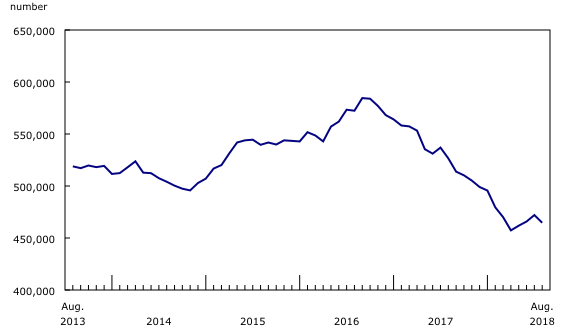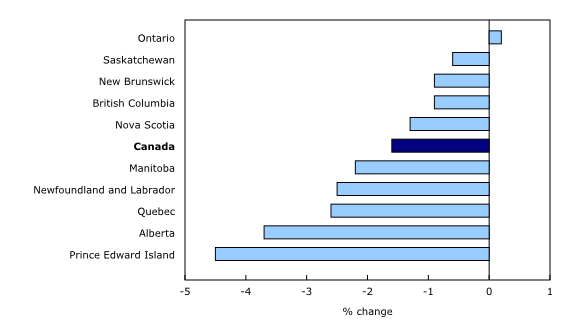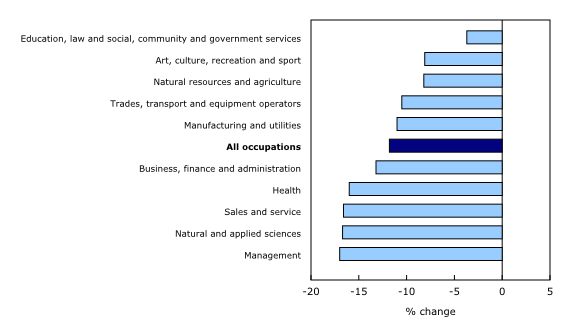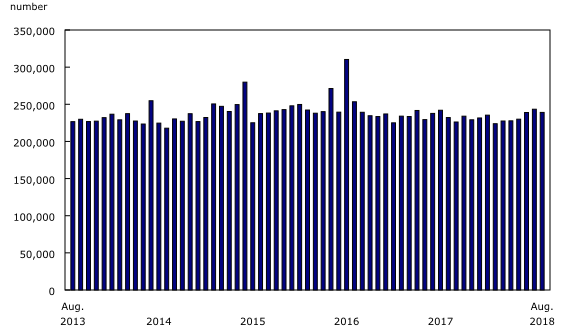Employment Insurance, August 2018
Archived Content
Information identified as archived is provided for reference, research or recordkeeping purposes. It is not subject to the Government of Canada Web Standards and has not been altered or updated since it was archived. Please "contact us" to request a format other than those available.
Released: 2018-10-18
In August, 464,700 people received regular Employment Insurance (EI) benefits, down 7,400 (-1.6%) from the previous month.
The number of beneficiaries fell in the majority of provinces, with the largest percentage declines in Prince Edward Island (-4.5%), Alberta (-3.7%), Quebec (-2.6%), Newfoundland and Labrador (-2.5%), Manitoba (-2.2%) and Nova Scotia (-1.3%). There was little change in Ontario.
Compared with August 2017, the number of EI recipients in Canada declined by 61,900 (-11.8%).
In general, variations in the number of beneficiaries can reflect changes in the circumstances of a number of different groups, including those becoming beneficiaries, those going back to work, those exhausting their regular benefits, and those no longer receiving benefits for other reasons.
Provincial and sub-provincial overview
In Prince Edward Island, the number of EI recipients declined by 4.5% in August to 7,600, offsetting the increase in July. Declines were observed across most of the province. Compared with August 2017, the number of beneficiaries fell by 2.6%.
There were 52,300 people receiving EI benefits in Alberta in August, down 3.7% from July and continuing the downward trend that began in the fall of 2016. In August, the number of beneficiaries decreased the most in the census metropolitan area (CMA) of Edmonton, falling by 5.0% to 19,600. In the 12 months to August, Alberta continued to have the fastest year-over-year decline among the provinces, with the number of recipients down 23.0%. Data from the Labour Force Survey (LFS) report that the unemployment rate for the province fell from 8.1% to 6.7% over this period.
In Quebec, the number of beneficiaries fell by 2.6% to 117,000, following three consecutive monthly increases. There were fewer recipients in three of the six CMAs, including Saguenay (-8.3%), Québec (-6.4%) and Trois-Rivières (-3.6%). In the 12 months to August, the number of beneficiaries in the province fell by 10.8%. Over the same period, the provincial unemployment rate, as reported by the LFS, decreased by 0.4 percentage points to 5.6%.
The number of people receiving EI benefits in Newfoundland and Labrador was down 2.5% in August to 34,900. This decline continued the downward trend that began at the end of 2017. On a year-over-year basis, the number of EI recipients fell by 10.2%. Despite fewer EI recipients, the unemployment rate, as reported by the LFS, was little changed over the period.
In August, the number of EI recipients in Manitoba fell by 2.2% to 15,700. There were fewer beneficiaries in areas outside the CMA and census agglomerations (CAs) (-2.5%), and in the CMA of Winnipeg (-2.0%). In the 12 months to August, the number of people receiving benefits in Manitoba was little changed.
The number of people in Nova Scotia who received EI benefits in August declined by 1.3% to 26,900. There were 2.2% fewer recipients in the Halifax CMA and in the CA of Cape Breton. Compared with August 2017, Nova Scotia had 3.5% fewer beneficiaries.
In Ontario, the number of EI beneficiaries was virtually unchanged in August at 120,400. Among the CMAs, the largest percentage increases were in Guelph (+6.5%) and Oshawa (+6.2%). The Toronto CMA posted a 2.2% increase. In contrast, there were declines in London (-4.1%), Windsor (-3.9%) and the CMA of Ottawa–Gatineau (Ontario part) (-2.5%). On a year-over-year basis, the number of recipients in the province fell by 10.1%. Over the same period, the LFS reported employment growth of 1.1% in the province.
Employment Insurance beneficiaries by occupation
Compared with 12 months earlier, the number of EI beneficiaries decreased in all 10 broad occupational groups in August. Those whose last job was in management led the declines (-17.0%), followed closely by occupations in natural and applied sciences (-16.7%) and occupations in sales and service (-16.6%).
Employment Insurance claims
There were 239,100 claims in August, down 1.8% from July. The number of claims provides an indication of the number of people who could become beneficiaries.
Prince Edward Island (-11.1%) and Alberta (-7.9%) recorded the largest percentage declines, followed by Quebec (-3.6%), Saskatchewan (-3.4%) and Manitoba (-2.3%). In contrast, there were more claims in Nova Scotia (+2.4%) and Ontario (+1.2%). There was little change in the other provinces.
In the 12 months to August, the number of claims increased by 3.0% at the national level.
Note to readers
Concepts and methodology
The analysis presented here focuses on people who received regular Employment Insurance (EI) benefits related to job loss. Claims data pertain to initial and renewal claims received for any type of EI benefits, including special benefits.
EI statistics are produced from administrative data sources provided by Service Canada and Employment and Social Development Canada. These statistics may, from time to time, be affected by changes to the Employment Insurance Act or administrative procedures.
Regular EI benefits are available to eligible individuals who lose their jobs and who are available for and able to work, but cannot find a job. To receive EI benefits, individuals must first submit a claim.
EI statistics indicate the number of people who received EI benefits, and should not be confused with Labour Force Survey (LFS) data, which provide estimates of the total number of unemployed people. There is always a certain proportion of unemployed people who do not qualify for benefits. Some unemployed people have not contributed to the program because they have not worked in the past 12 months or their employment was not insured. Other unemployed people have contributed to the program but do not meet the eligibility criteria, such as workers who left their job voluntarily or those who did not accumulate enough hours of work to receive benefits.
All data in this release are seasonally adjusted. For more information on seasonal adjustment, see Seasonally adjusted data – Frequently asked questions.
Numbers in the Daily text are rounded to the nearest hundred.
The number of regular EI beneficiaries and the number of claims received for the current and previous month are subject to revision.
The number of beneficiaries is a measure of all people who received EI benefits from August 12 to 18. This period coincides with the reference week of the LFS. However, claims data are for the entire month.
Geographical definitions
A census metropolitan area (CMA) or a census agglomeration (CA) is formed by one or more adjacent municipalities centred on a population centre. A CMA must have a total population of at least 100,000. A CA must have a population of at least 10,000. See Standard Geographical Classification 2011 – definitions for more information.
Next release
Data on Employment Insurance for September will be released on November 22.
Products
More information about the concepts and use of Employment Insurance statistics is available online in an updated version of the Guide to Employment Insurance Statistics (73-506-G).
Contact information
For more information, contact us (toll-free: 1-800-263-1136; 514-283-8300; STATCAN.infostats-infostats.STATCAN@canada.ca).
To enquire about the concepts, methods or data quality of this release, contact Vincent Ferrao (613-951-4750; vincent.ferrao@canada.ca) or Client Services (toll free: 1-866-873-8788; statcan.labour-travail.statcan@canada.ca), Labour Statistics Division.
- Date modified:







